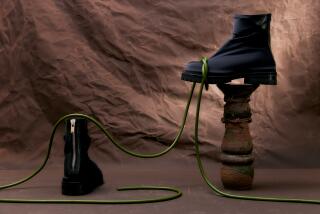Geoffrey Beene, 77; Designed Fashions for the Modern Woman
- Share via
Geoffrey Beene, the New York designer whose fashions ranged from suits and coats as sleek as modern sculpture to evening dresses as colorful and frothy as wedding cakes, died Tuesday at his home in New York City. He was 77.
Beene died of complications of pneumonia, according to Helen O’Hagen, a longtime friend and the former communications director for Saks Fifth Avenue in New York City.
A Southern gentleman in a rough and competitive business, Beene made strong impressions with his courteous manner as well as his highly original style.
On the one hand, he was a champion of minimalist design. The short, A-line dresses and body-contoured jumpsuits he was known for were marvels of cut and proportion.
At the same time, his evening collections featured layers of fabrics and prints, some of them embroidered with dots and trimmed with delicate lace. Everything he designed had a hand-crafted, artisan’s quality that made more familiar-looking clothes seem predictable.
“He never wanted to appeal to the mass market,” recalled Betty Leonard, a former vice president of I. Magnin in Beverly Hills, which carried Beene’s label until the department store chain closed in 1995. “His designs were understated, and they all looked like one of a kind. They appealed to well-educated, professional women who had a strong sense of themselves.”
Beene was among the first designers of his level to use fine-quality rayon and other synthetic fabrics for his collections, partly because they resisted wrinkles. He sometimes worked with Asian manufacturers to create his own prints. One memorable fabric reproduced the scales of a shark’s skin.
He was an innovator in business as well. In 1974, he pioneered a lower-priced “Beene Bag” label for casual clothes that cost a fraction of his signature collections. He was among the first American designers to produce and sell his collections in Europe. He was also one of the first American designers to have a chain of boutiques in Europe and Japan.
Beene developed a menswear business that led to a license agreement with Van Heusen for shirts. He also created fragrances for men and women. His Grey Flannel scent for men was particularly popular.
Fashion editors and store buyers knew Beene to be tirelessly inventive when it came to ways of presenting his latest designs. He installed museum-like exhibits and once showed an art house-style film where the characters dressed in his newest collection.
He was not as widely known as fashion contemporaries Bill Blass and Oscar de la Renta, but he attracted a following that included former First Ladies Pat Nixon and Nancy Reagan, and former Vogue magazine editor Grace Mirabella. President Lyndon B. Johnson’s daughter, Lynda Bird, wore a Beene wedding gown when she married Charles Robb in 1967.
“Geoffrey Beene was the real thing, a real designer with an original style,” said Kennedy Fraser, former fashion editor of the New Yorker. “He was very interested in modernity in every sense, where, generations of designers who came after him were interested in the retrospective.”
Beene credited Fraser with changing his approach to design in the early 1970s, from structured to more natural shapes. She had described his work in less-than-flattering terms. “I said that some of the clothes looked like flight attendants’ suits,” she recalled in an interview with The Times on Tuesday.
Beene stunned her by writing Fraser a thank you note. “It says a great deal about his modesty and his open-mindedness, that he would do such a thing,” she recalled.
Beene’s view of style was more about function than fad.
“I have tried to contribute to the comfort of clothes by breaking down the barriers and dictates that weren’t logical to me,” he told The Times in 1985.
He also cautioned against getting too concerned with the latest trends.
“The most important thing that I tell women is not to believe everything they read about fashion,” he told The Times in 1985. “The influence of Paris, for instance, is now minimal. Yet a lot is written about Paris fashion. A woman should be less concerned about Paris and more concerned about whether the dress she’s about to buy relates to the way she lives. Fashion is treated too much as news rather than what it is, what it does and how it performs.”
From the time he opened his business in 1963, Beene received the highest fashion honors, starting with the first of eight Coty American Fashion Critics awards in 1964. His designs were displayed in several galleries and museums, including New York’s Fashion Institute of Technology in 1994 and the Cooper-Hewitt, National Design Museum in 2002.
Born in Haynesville, La., Beene planned to be a doctor like his grandfather and enrolled in medical courses at Tulane University in New Orleans. But his interest waned when the classes discussed vivisection and cadavers and he dropped out. He moved to Los Angeles with plans to attend USC, but took a job in the display department at I. Magnin. That experience changed his career goals.
The following year he entered New York’s Traphagen School to study fashion and from there went to Paris to study tailoring. He returned to New York in 1951 and held jobs in several fashion houses. He designed for Teal Taina from the mid-1950s until he started his own company in 1963.
No services are planned, according to O’Hagen. He is survived by one sister.






